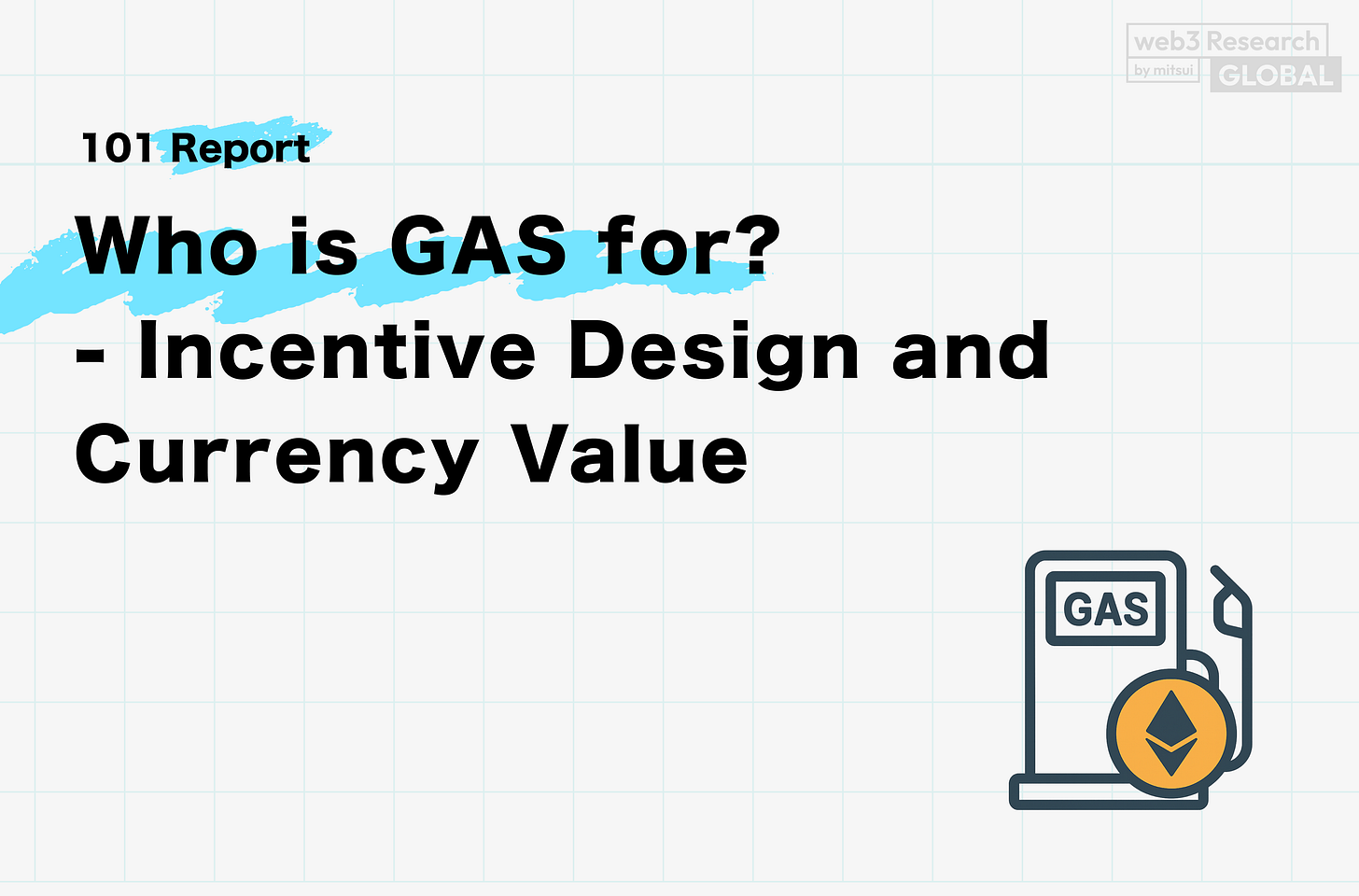Who is GAS for? - Incentive Design and Currency Value【Part 2】
Where is the intrinsic value of the gas price?
Good morning.
Mitsui from web3 researcher.
Today's report is a basic report on the basics of web3, so we're going to take an in-depth look at "gas costs".
What you will learn
Be able to understand the meaning, structure, and calculation of the GAS fee: Understand the logic behind why a fee is charged for each transaction sent.
Who pays the GAS fee and who receives it?: We can understand the incentive structure to keep the network secure.
Decipher the "ideology" and "economic design" of the blockchain from a gas perspective:L2 and other chain (e.g. Solana) mechanisms will also be compared to learn what the gas generation essentially supports.
Currency Value and "Forced Demand": From a tax and monetary theory perspective, "the gas price is what makes the token valuable"We understand the idea that.
Future Prospects/Optimization:Understand why reducing gas bills and improving scalability are important, including L2 solutions and sharding.
Now the second part begins.
Introduction: review of the previous part and aims of this part
1. Who is gas for? - Network security and fair use
2. "Forced demand" and currency value created by gas3. gas optimization trends and L2 solutions
4. comparison with other chains: Solana, Avalanche, PolygonAvalanche, Polygon, etc.
5. The "economic infrastructure" of gas shows the essence of web36. Summary: gas shows web3's "incentive design" and "currency value"
7. Summary of the second part: understanding gas reveals the foundation of web3
A postscript
🧵TL;DR
gas is a mechanism that supports the healthy operation of the network and rewards validators, and serves as a "usage rule" to maintain fairness and security.
Because Ethereum requires the gas fee to be paid in ETH, there is a forced demand for the currency and a structure where the scarcity and value of ETH is supported by the base fee burn.
To keep soaring gas costs down, L2 scaling methods such as Optimistic Rollup, ZK Rollup, and sharding are rapidly gaining popularity.
Other chains (Solana, Avalanche, Polygon) handle gas with different design philosophies, and the differences in gas design define the philosophy and strengths of each blockchain.
Introduction: review of the first part and aims of this part
In the first part ("What is GAS in the first place? - What is a commission and what does it mean?"),
The basic structure of the GAS
Who is paid and how is it used?
Transaction examples and gas calculation formulas
Why do gas fees skyrocket?
In this article, we explained that gas is more than just a fee, but also plays a major role in supporting the security and incentives of distributed networks.
Now, if we take a deeper look at the question, "For whom is the gas fee essentially 'for whom'?"If we delve one step deeper into the question, "For whom is gas money essentially 'for'?
Furthermore, if we look at "gas optimization" and "differences between other chains and Ethereum" based on this, it will be easier to understand the philosophy and technology selection of each blockchain.
Let's look at them in order.
1. who is gas for? - Safe and fair use of the network
1-1. balance of "cost burden" created by gas
As mentioned in the previous part, blockchain is a mechanism for decentralized consensus building among nodes around the world.
There is no central server.
Everyone keeps the same ledger and verifies transactions against each other."
The higher the degree of this distribution, the more censorship-resistant and secure the network becomes, but on the other hand, the more computing resources and storage are distributed across many nodes, which increases the load.
So the question arises, "What if someone sends a large number of transactions?"The question becomes, "What if someone sends a large number of transactions?If all usage is free, a malicious user could spam (DDoS) without limit and interfere with other users' transactions.
However, by putting a cost per transaction (i.e., setting a GAS fee), it becomes a powerful deterrent.Spamming costs a large amount of money, and it is not a "free to harass" situation.
The "if you want to run a smart contract that consumes a lot of computing resources, you pay a reasonable cost" rule is also a mechanism to maintain fairness.
The more complex the process, the more gas is consumed, so fewer people will bother to perform unnecessary calculations.In this sense, gas is a game rule to "make people use the network correctly.
1-2. Incentive aspect: Make the validator work correctly
By paying the gas fee, the validators (formerly miners) who generate and validate the blocks are rewarded.
After Ethereum's PoS transition, priority fee (tip) is part of the validator fee
The base fee is a burn mechanism (EIP-1559)
Thus, validators are "rewarded if they support the network operation correctly.Conversely, if you misbehave, you will be thrashed (forfeit your pledged ETH), so it is financially beneficial to behave honestly.
Who is GAS for?If we ask, there are two aspects: (1) "a mechanism to keep the use of the network fair" and (2) "a mechanism to pass on rewards to validators.In addition, the "mechanism to support currency value," which will be discussed later, is also involved.
2. "Forced demand" and currency value created by gas
2-1. Basis for Layer 1 Token: Similarity to Tax-Driven Money
Keep reading with a 7-day free trial
Subscribe to DEBUNK(web3 Research) to keep reading this post and get 7 days of free access to the full post archives.


